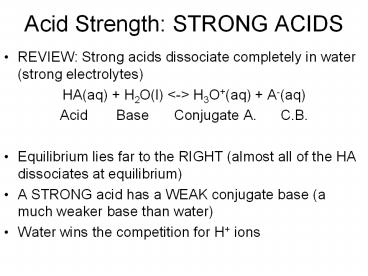Acid Strength: STRONG ACIDS - PowerPoint PPT Presentation
Title:
Acid Strength: STRONG ACIDS
Description:
... etc. For a typical weak polyprotic acid, Ka1 Ka2 Ka3 the acid will get successfully weaker *For a typical polyprotic acid in water, ... – PowerPoint PPT presentation
Number of Views:168
Avg rating:3.0/5.0
Title: Acid Strength: STRONG ACIDS
1
Acid Strength STRONG ACIDS
- REVIEW Strong acids dissociate completely in
water (strong electrolytes) - HA(aq) H2O(l) lt-gt H3O(aq) A-(aq)
- Acid Base Conjugate A. C.B.
- Equilibrium lies far to the RIGHT (almost all of
the HA dissociates at equilibrium) - A STRONG acid has a WEAK conjugate base (a much
weaker base than water) - Water wins the competition for H ions
2
ACID STRENGTH WEAK ACIDS
- HA(aq) H2O(l) lt-gt H3O(aq) A-(aq)
- Acid Base Conjugate A. C.B.
- Very little dissociation of HA
- Equilibrium lies far to the LEFT
- Conjugate base is a much stronger base than water
- Water loses the competition for H ions
3
Common Strong Acids MEMORIZE!!
- Sulfuric Acid H2SO4(aq)
- Hydrochloric Acid HCl(aq)
- Nitric Acid HNO3(aq)
- Perchloric Acid HClO4(aq)
- Diprotic acids have two acidic protons (H2SO4)
- H2SO4(aq) -gt H(aq) HSO4-(aq) strong
- HSO4-(aq) lt-gt H(aq) SO42-(aq) weak
- Monoprotic acids have one acidic proton
4
Acids
- Oxyacids acidic proton is attached to an oxygen
atom (weak and strong) - Organic Acids acids with a carbon atom backbone,
commonly contain the carboxyl group (usually weak
acids)
5
Ka
- For monoprotic acids, Ka can be used to determine
strength - Larger Ka stronger acid equilibrium lies
farther RIGHT - BASE STRENGTH opposite of acid strengthlarger
Ka stronger acid weaker conjugate base - Water acts stronger than weak, but weaker than
strong )
6
Monoprotic Ka Values
7
Water
- Amphoteric substances can act as either an acid
or a base (ex water) - H2O(l) H2O(l) -gt H3O OH-
- Equilibrium Kw H3OOH-
- Kw ion-product constant (dissociation constant
for water) - At 25C in pure water H3O OH- 1.0 X 10-7
M, so Kw 1.0 X 10-14
8
About Kw
- In any aqueous solution at 25C, no matter what
it contains, HOH- must always equal 1.0 X
10-14 - Neutral solutions, H OH-
- Acidic solutions, H gt OH-
- Basic solutions, OH- gt H
- NO MATTER WHAT, at 25C,
- Kw HOH- 1.0 X 10-14
9
Examples
- Calculate H or OH- as required for each of
the following solutions at 25C, and state
whether the solution is neutral, acidic, or
basic. - 1.0 X 10-5 M OH-
- 1.0 X 10-7 M OH-
- 10.0 M H
10
Temperature
- The equilibrium constant Kw varies with
temperature - If Kw increases with temperature, energy is a
reactant (endothermic) - I will not ask you questions about these
11
More Complex Example
- At 60C, the value of Kw is 1 X 10-13
- Using Le Chateliers principle, predict whether
the following reaction is exothermic or
endothermic - 2H2O(l) lt-gt H3O(aq) OH-(aq)
- Calculate H and OH- in a neutral solution at
60C
12
pH Scale
- Ranges from 0-14 and represents the small
concentrations used in the Kw expression for
OH- and H - pH -logH
- pOH -logOH-
- pK -log K
- Log scale is based on 10, so the pH changes by 1
for every power of 10 change in H - ACIDS low pHs, BASES high pH, NEUTRAL pH 7
13
Example
- Fill in the following table
- Significant figures The of decimal places in
the log SF in the original
pH pOH H OH- Acid, base, neutral
Soln A 6.88
Soln B 8.4 X 10-14
Soln C 3.11
Soln D 1.0 X 10-7
14
Polyprotic Acids
- Acids can break up into more than one proton (ex.
H2SO4 diprotic or H3PO4 triprotic) - Ka describes the first proton, Ka2 describes the
second, etc. - For a typical weak polyprotic acid, Ka1 gt Ka2 gt
Ka3the acid will get successfully weaker - For a typical polyprotic acid in water, only the
first dissociation step is important in pH
calculation
15
Example
- Using table 14.4 in your book, calculate the pH
of a 1.40 M H2C2O4 (oxalic acid) solution and the
equilibrium concentrations of H2C2O4, HC2O4-,
C2O42-, and OH-. - ICE table necessary
16
Example 2
- Using data from Table 14.4 in your textbook,
calculate the pH, PO43-, and OH- in a 6.0 M
phosphoric acid (H3PO4) solution.































